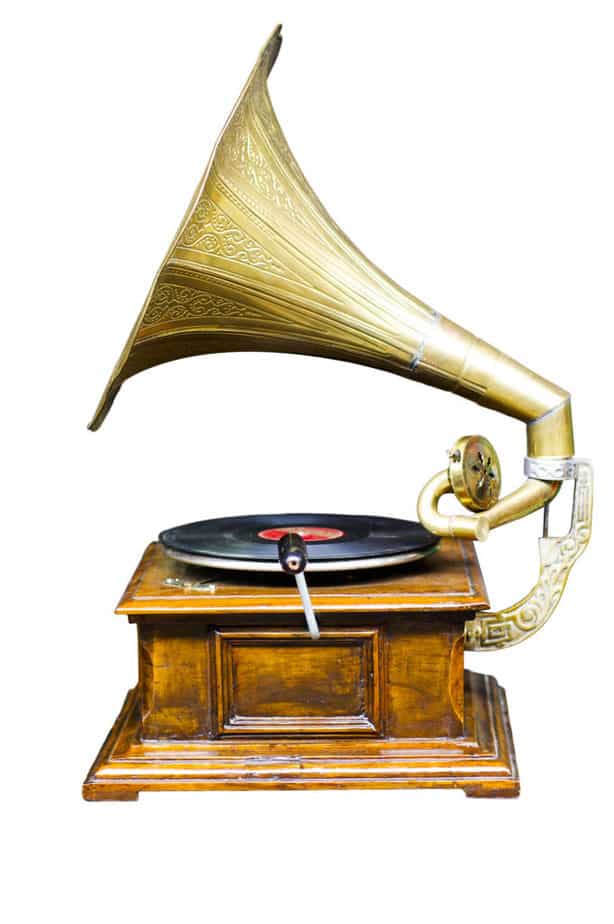
Victrola was a trademarked (1901) gramophone marketed by the Victor Talking Machine Company, an American record company, in 1906. It was the most popular home-based phonograph available in the 1920s and 30s. The company continued to manufacture and sell these until the late 1960s. According to Eldridge R. Johnson, the company head, the name Victrola was coined for it had rhymed with pianola and was indicative of a ‘sound suggestive of music’. Pianola is a trademarked name for a self-playing piano, which operates on a mechanical principle that uses programmed music recorded on perforated rolls of paper. Read more to find will a victrola ruin records.
History
A Victrola is a disc record player, using a vibrating needle to amplify acoustics. Before 1925, a recording was done through purely mechanical means i.e. without the use of microphones and electronic amplifiers. In 1906, Victor Co. introduced the new gramophones. It consisted of a turntable, the needle and the amplifying horn. The horn was a complete tuckable attachment that could be kept away in a wooden cabinet. The idea behind this was to increase visual aesthetics, thereby promoting it as a fancy piece of furniture, rather than a bulky machine.
With the advent of the Victor age, Johnson was involved in improving records, the recording processes and delivering quality to listeners. After the invention and mass manufacture and availability of the radio, Victor switched from the old acoustical recording format to microphone-based electrical methods. These events lead to Victor inventions of the Electrola, the Radiola and musical instruments such as the Theremin.
Are Victrolas Still Relevant?
With the advancement in audio applications and recording processes, the Victrola had seen a vast array of improvements and to date survives as a brand that has made a prominent impact when it comes to audio recorders and players. As retro style is coming back to life, records are becoming popular once again. The pandemic had seen a vast growth of record sales as compared to the previous years. When it comes to buying record players, Victrola is still a trusted brand and has a wide range to choose from.
Parts Of A Record Player
The major components of a record player are:
- Turntable – The rotating part of the player where the record is placed. It is made up of metal (generally steel or aluminum) or plastic and has a rubber mat to protect the records.
- Stylus – The needle that is placed atop the record and moves over its grooves. Either elliptical or spherical and usually made out of diamond or sapphire.
- Tone Arm – Holds and connects the stylus to the overall casing of the player, with the aid of a flexible metal strip. These are either straight, curved or S-shaped.
- Cartridge – The part responsible for translating the grooves read by the stylus into acoustics.
- Pre-Amplifier and Amplifier – These are responsible for the various sound frequencies provided by the player.
Mechanism
Firstly, the vinyl record sits over the turntable and the stylus is placed over it. As the turntable rotates with the record, the stylus moves over its grooves. The vibrations of the stylus traveling over the record’s grooves are sent to the cartridge through wires in the tonearm. These vibrations are received by coils surrounded by a magnetic field inside the cartridge and are converted to electrical signals. These electrical signals are further sent to pre-amplifiers, amplifiers and speakers to get transformed into sound.
What Is A Quality Record Player?
A good player should be able to significantly reproduce the sound, amplify it and not cause harm to the record. Thus the most vital elements to look out for are the quality of the tonearm and the cartridge. Plus, it is an added advantage if the player has a replaceable stylus. Most styluses are to be supposedly replaced after around 1000 hours of record playing time. Moreover, the casing should be comparatively heavier and the turntable preferably of heavier metal, to avoid excessive vibrations to ensure less impact on the stylus and reduced risks of scratches on the vinyl records.
Things To Lookout For While Investing In Cheap Record Players
The prospect of owning a record player is enticing but let us be practical, it is an expensive investment. Thus, we naturally vibrate towards cheaper or adaptable versions. But the most important fact remains that cheap records players bought without much thought can actively damage our precious records.
In general, we should make sure, the player has a counterweight, an anti-skate and the proper sized platter and stylus. The counterweight balances the weight of the tonearm and cartridge without weighing down the stylus, which would otherwise eventually damage the record. An anti-skate ensures to restrict the tonearm movement so that it doesn’t swing to the center or the extremes of the record. An undersized turntable will make the record flex while the stylus moves over the grooves and produce a bad sound in addition to damaging it. Hence, the perfectly sized turntable is a must. The size of the stylus is a major reason for concern. A rather large-sized stylus would come out of the grooves causing skips and drags over the vinyl. Similarly, a small-sized one will dig into the record further damaging and reducing its lifespan.
Hence, be it a Victrola or a Byron Statics or a Sony Record Player or Turntable, a cheap, un-researched player can damage records. So, do your research.
